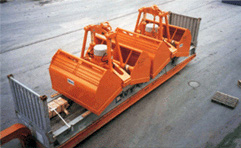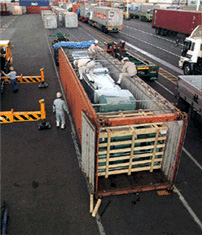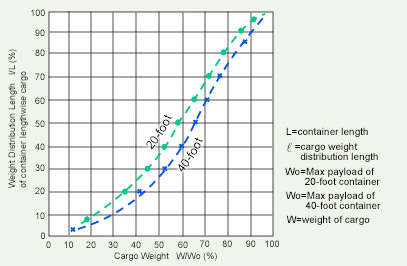Flat Rack Containers/Open Top Containers
Heavy cargo is the predominant cargo transported by this type of container. NYK’s flat rack containers have reinforced floors; these Flat Rack Containers can withstand concentrated loads on the central third of the container widthwise.
NYK possesses a large number of such containers.

For purposes of strength, 20′ and 40′ containers have floors of different heights. A 20′ Flat Rack Container has a floor height of approximately 30cm (12 inches), while a 40′ Flat Rack Container has a floor height of approximately 60cm (24 inches). Therefore cargo that would not be overheight on a 20′ Flat Rack Container may be overheight on a 40′ Flat Rack Container.
Be careful!

Open Top Containers
By fitting the polyethylene liner shown in the illustration below into the interior of a dry container, in-transit accidents such as the dirtying or wetting of contents can be eliminated. Its features are:
- It is highly applicable for clean cargoes since it is used only once.
- It is made of soft, pliable fabric with plenty of elasticity. This means it is easy to use and difficult to tear.
- It makes devanning easy and safe.
- By enabling the use of ordinary dry containers, container assignment becomes easy and it becomes possible to respond quickly to shipment timing.

About Floor Damage Due To Weight Concentrations: There have been cases in which floor beams have buckled and floorboards have broken due to weight concentrations being improperly dispersed in the cases of marble or heavy equipment loaded into containers overseas.
Should the floor collapse and cargo fall during cargo handling, people could be injured, the vessel damaged, and the cargo itself could be damaged. In the stowing of cargoes that have heavy weight per unit of surface, weight is to be dispersed by using cargo floor material in the container’s lengthwise direction. Be sure there are no weight concentrations! Refer to the graph below for container cargo weight distribution. Be sure to take into consideration the top left part.

When loading heavy cargoes such as steel or machinery, it is necessary to use dunnage such as support timbers or skids to distribute weight evenly on the floor.

Even when cargoes have the same weight, dispersing cargo weight through using dunnage with a large floor surface can considerably reduce the weight per unit of floor surface.
